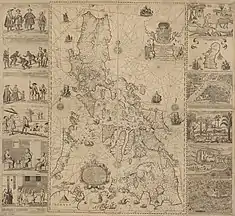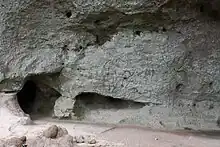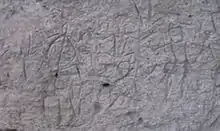Angono Petroglyphs
The Angono - Binangonan Petroglyphs are petroglyphs carved into a rock wall in Binangonan, Rizal, Philippines. It consists of 127 human and animal figures engraved on the rockwall probably carved during the late Neolithic, or before 2000 BC. They are the oldest known work of art in the Philippines.[1] These inscriptions clearly show stylized human figures, frogs and lizards, along with other designs that may have depicted other interesting figures but erosion may have caused it to become indistinguishable. The engravings are mostly symbolic representations and are associated with healing and sympathetic magic.[1]
Mga Petroglipo ng Angono Binangonan | |
 | |
.svg.png.webp) Location of Angono Petroglyphs in the Philippines | |
| Alternative name | Petroglyphs of the Rock-shelter Angono-Binangonan Petroglyphs |
|---|---|
| Location | Bilibiran, Binangonan, Rizal, Philippines |
| Coordinates | 14.532872°N 121.18679°E |
| Type | Cave |
| History | |
| Periods | Neolithic Period |
| Management | National Museum of the Philippines |
The site has been declared by the National Museum of the Philippines as a National Cultural Treasure in 1973. It is also included in the list of the World Inventory of Rock Art in 1985 and historic sites of the World Monuments Watch and World Monuments Funds[2] and part of the Philippines' tentative list of the UNESCO World Heritage Site.
History
| History of the Philippines |
|---|
 |
| Timeline |
|
|


The existence of a rock shelter was reported to the National Museum by the late National Artist of the Philippines Carlos V. Francisco in March 1965 during a field trip with several boy scouts along the boundaries of Angono, Binangonan and Antipolo of the province of Rizal.[2][3][4] Since then, some rock carvings have been damaged due to neglect and vandalism. In 1973, by virtue of Presidential Decree No. 260, it was declared as a national cultural treasure by the Philippine government.[5] During that time, a team led by the National Museum of the Philippines started archaeological site conservation and site development of the petroglyphs in which a mini-museum, view deck and stone path, among others, were constructed. It was included in the list of National Cultural Treasures in 1973 and World Inventory of Rock Art in 1985.
In 1996, The World Monuments Fund included Angono Petroglyphs on its list of preservation projects and has helped with the installation of a drainage system and assigned a caretaker to protect the site.[6] The site is also on the tentative list of UNESCO World Heritage Sites of the Philippines.[7]
Description
The Angono Petroglyphs is located in a shallow rock shelter. It measures 63 meters wide, 8 meters deep and a maximum height of 5 meters. It has been created due to faulting and formed in volcanic soil during the Quaternary period. There are 127 drawings in the form of animate and static figures of circular or dome-like head on top of a 'V' shaped torso distributed on a horizontal plane on the rock wall area measuring 25 meters by 3 meters. Only 51 of the total 127 drawings are distinct. Due to the complexity and plurality of the drawings, it is suggested that the drawings on the rock were not only created by a single individual. It is widely believed that the figures drawn on the walls are for healing purposes as the site is a dambana. Researchers have argued that the figures were medicinal and religious in function as they were made by ancestors to transfer the sickness of a child onto the limestone wall, thus, curing the child from ailments.[2]
Archaeological excavations
From October to November 1965, archaeological excavations, headed by Alfredo Evangelista, was done on the area of the rock shelter.[4] Fragmented bits of earthenware, two pieces of obsidian flakes, two chert, flake stone tools, one stone core tool and polished stone adze with a blunted working edge were excavated in the rock shelter. The artifacts suggest that the site was used during the Neolithic age, or earlier than 2000 BC.[2]
In 2018, Jalandoni & Taçon proposed that the petroglyphs consist of two different phases created by different cultures. The older Phase 1 is composed of around 51 geometric shapes; including 11 disembodied vulva forms that are depicted as bisected triangles or ovals, small holes (cupules), and at least one human figure with bent elbows and knees. Phase 1 is believed to be created by Australo-Melanesian (Negrito) hunter-gatherers using stone tools.[8]
Phase 2, on the other hand, modified Phase 1 petroglyphs by adding limbs, heads, and torsos to previous stick human figures. Some depicted as having horn-like or rectangular-shaped headdresses, while three were holding curved objects. Four of the human forms had a bowling pin shape, three had oval bodies, and one had a "fishtail" for legs. Phase 2 is much more recent, with much sharper edges and lines, and may have been carved by Austronesian hunter-gatherers.[8]
Modern graffiti also contaminate the site, and there is a possibility that Phase 2 may also possibly be modern and carved by Philippine guerilla forces hiding in the caves during World War II.[8]
Management
The preservation and development of the Angono Petroglyphs is a collective effort of the National Museum of the Philippines, the Department of Tourism, World Monuments Fund, American Express and a Philippine real estate company.[9]
It was first opened to the public in 1989, with a green-painted iron fence and a low concrete wall separating the rock wall from viewers. The previous landowner, Antipolo Properties Inc. donated the land directly in front of the shelter to the National Museum, and they also maintain access roads, cleared vegetation, and bore a tunnel through the ridge for easier access by tourists.[8]
A viewing deck was installed by the National Museum in 1997. The site was closed for 14 months until October 2015 for renovations and the installation of a newer viewing deck. Graffiti by visitors is a problem. And though the site provides "visitor books" for guests to draw upon, these are rarely used as they are safeguarded by the National Museum staff. The tunnel leading to the area is not monitored and is also the site for graffiti by visitors, though these may have a positive impact as it channels away graffiti from the main site.[8]
The site of the Angono Petroglyphs is developed as the Angono Branch of the National Museum showcasing the cultural and artistic heritage of the province of Rizal.[4] Its collections include remains of giant turtle, tusks, fossils, molar of Elephas sp., tradeware ceramics and paintings.
References
- "Angono Petroglyphs". UNESCO. Retrieved May 2, 2014.
- "The Angono-Binangonan Petroglyphs". Artes de las Islas Filipinas. Retrieved September 3, 2014.
- Zulueta, Lito (August 15, 2008). "Jose Blanco, Angono folk muralist, dies; 76". Philippine Daily Inquirer. Archived from the original on November 22, 2008. Retrieved October 17, 2008.
- "Angono Petroglyphs". National Museum of the Philippines. Archived from the original on January 17, 2016. Retrieved September 14, 2014.
- "Presidential Decree No. 260 August 1, 1973". The Lawphil Project – Arellano Law Foundation. Retrieved September 5, 2014.
- "Angono Petroglyphs". World Monuments Fund. Retrieved September 12, 2014.
- Macaraig, Mynardo (April 20, 2014). "Angono petroglyphs, PHL's oldest artworks, in danger of disappearing". GMA News. Retrieved September 12, 2014.
- Jalandoni, Andrea; Taçon, Paul S.C. (2018). "A new recording and interpretation of the rock art of Angono, Rizal, Philippines". Rock Art Research. 35 (1): 47–61.
- "Petroglyphs". Municipality of Angono, Rizal. Archived from the original on January 27, 2015. Retrieved September 12, 2014.
